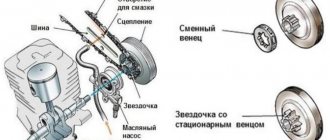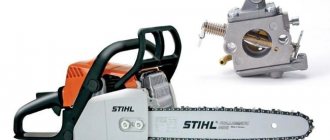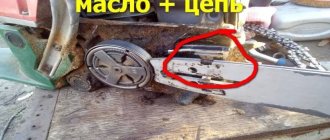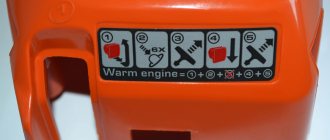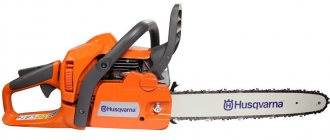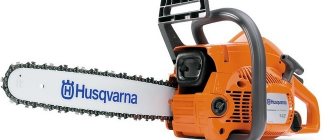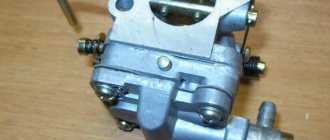It is probably no secret to anyone that such an irreplaceable, multifunctional and universal device as a chainsaw is an integral part of the life of each of us. This especially applies to that part of our life when we carry out work of any nature in the agricultural field. But it is worth noting that buying a chainsaw model you like, and one that would fully meet your wishes and preferences, is, as they say, only part of the story. It is equally important to create conditions for this tool under which it would have the opportunity to serve you for more than one year, delighting you with its work and productivity. Therefore, like any equipment, a chainsaw needs care for its body , the main parts, and what can I say, even the smallest additions to the tool need repair or replacement. Therefore, this article will be dedicated specifically to the issue that will concern the processing and running of this device. Here you can find out why it is so important to carry out this kind of manipulation with the device and, in general, how it should be done correctly. But initially you need to decide on the model, and our rating of the best chainsaws will help you with this. So, let's begin to consider this topic.
Running in a new chainsaw or the importance of this event
During the grinding of parts, working gaps are formed between the cylinder and the piston rings. Even at the break-in stage, compression in the cylinder increases, which has a positive effect on the operation of the internal combustion engine and the power of the tool. The procedure allows you to increase the service life of a two-stroke engine, and if you do not pay attention to this process, the engine may jam the first time you use the chainsaw.
In addition to reducing the service life of internal combustion engine parts in the absence of running-in, the engine will work significantly worse, and instead of the amount of horsepower declared by the manufacturer, the tool will produce 2 times less. Any new chainsaw needs running-in, regardless of who its manufacturer is. You also need to run in chainsaws that have undergone engine overhauls, but we’ll talk about that separately. Not only does the internal combustion engine of a new chainsaw need grinding in, but also the saw set - the chain and bar.
Many beginners wonder whether running in a chainsaw is necessary. And sometimes a simple answer is not enough for a person to understand how important it is to break in the tool. To understand the importance of break-in, you need to know what happens when you start the engine:
- After the chainsaw engine starts, the fuel-air mixture burns in the cylinder, causing the cylinder, piston and other structural parts to heat up.
- When heated, the parts expand, resulting in an increase in the coefficient of friction.
- The higher the friction coefficient, the more the parts heat up. If critical temperatures are reached, a piston melting effect will occur, which will immediately lead to jamming of the internal combustion engine.
- To eliminate this process, you need to run in the chainsaw. It is a procedure where the engine of the tool is operated without load or with short-term average loads.
There are different opinions among tool owners about how to properly break in a chainsaw. Some masters recommend carrying out the procedure exclusively by running the engine at idle, while others, on the contrary, believe that the tool should be allowed to work not only at idle, but also under moderate load. Having figured out the question of whether running in a tool is necessary, let’s move on to clarifying the features of the correct execution of the procedure.
First launch
When everything is ready to launch, you can try to start the engine:
- The ignition switch is moved to the operating position.
- If there is a primer on the carburetor, press the button until the fuel mixture enters there.
- The saw is installed on a level platform so that the chain does not touch the ground.
- With your left hand, press the saw down by the handle.
- With your right foot, step on the inside of the protective shield of the working handle.
- The air damper is closed one hundred percent.
- Gently pull the starter handle up until the play in the ratchet mechanism is selected, and then jerk it sharply, turning the engine crankshaft.
- After signs of ignition occur (popping noises in the cylinder), the air damper is opened and the saw is tried to start.
The first start of the chainsaw may require some time to start with the air damper closed, especially in cool weather.
Is it necessary to load the chainsaw during break-in?
Some tool sellers recommend that after purchasing a chainsaw, buyers carry out the process of grinding in parts with complete elimination of the load. It even goes so far as to have owners remove the chain and bar and let the engine run at zero load. Is this approach to the procedure considered correct? This approach is not recommended for the following reasons:
- Not only the internal combustion engine parts need grinding, but also the saw set, or more precisely, the chains, tires and sprockets.
- Idling will not allow you to achieve the required load, so after the end of the process, when work is performed at high speeds, the motor may jam.
- The rotation of the chain when starting the engine of a new chainsaw provides the optimal load value, so the tool runs in not only more efficiently, but also faster. To complete the grinding as quickly as possible, the tool is gradually loaded by sawing wood of a small diameter.
- Idling the engine causes a reduced amount of mixture to enter the combustion chamber. Its insufficient volume prevents optimal lubrication of moving parts, thereby increasing their wear.
That is why, before you start running in the chainsaw, you need to install the bar and chain on the tool and ensure the correct tension. Next, you will need to fulfill some more important conditions:
- Prepare a benzine-oil mixture. Instructions for preparing the mixture for a chainsaw are described in detail here. However, when running in, it is important to maintain other proportions, as described in detail below.
- Fill the tank with chain oil, which lubricates the bar and chain. The chain can be placed in oil for several hours.
Interesting to know! The duration of grinding in chainsaw parts is measured not by the operating hours of the engine, but by the amount of fuel burned. To ensure effective running-in of the tool, it is necessary to burn at least 3-5 tanks of fuel. The maximum running-in duration lasts 6-8 burned tanks of fuel. The best option is to read the instructions, since each manufacturer indicates this information, which should be followed.
Features of setting up Husqvarna saws
The manufacturer Husqvarna installs a testing mode for the fuel enrichment system on all saws at the factory, which will need to be replaced with a working one by adjustment. In testing mode, the maximum possible number of engine revolutions is less by almost 700 units compared to the value stated in the technical documentation.
You can only adjust the maximum frequency of the power plant using a tachometer, otherwise you may make a serious mistake. For example, setting the number of revolutions higher than necessary and damaging the saw. The engine frequency is adjusted using jet N.
If you were adjusting the carburetor, and while the engine was idling, the chain began to move, then the problem lies in the incorrect setting of the T screw; it needs to be turned counterclockwise again.
The general rules for adjusting the operation of the Husqvarna chainsaw carburetor using model 142 as an example are as follows:
- Warm up the instrument. This will take about 10 minutes;
- Place it on a flat surface, such as a table. Place it so that the chain is not directed at you;
- To determine the highest operating frequency of the motor, turn screw L first to the right, then slowly turn it to the left. Listen to the engine;
- After detecting by ear the maximum speed, turn the L control in the direction opposite to the clockwise movement 1/8 or a quarter of a full circle;
- Idle speed is adjusted according to the same principle. First turn it to the right until the chain starts moving, and then turn it to the left until it stops again;
- Screw H is installed so that no extraneous noise is heard when the engine is running without load and at maximum frequency. If there is too much exhaust gas and the saw begins to make an unpleasant clanging noise without load, then the mixture is too rich. By turning screw H clockwise, you can adjust the opening angle of the throttle valve.
Important! If this is your first time setting up a carburetor, then before starting work, study the video or technical documentation of your saw.
How to properly prepare a gasoline-oil mixture for a chainsaw during break-in
As has already been said, during the process of running in a chainsaw, grinding in of parts occurs. To increase the quality of grinding in parts, it is recommended to fill the tank with gasoline with an increased amount of oil than recommended by the manufacturer. Why is this necessary? During lapping, an increase in friction is observed, so the parts heat up more. To reduce the heating temperature, the friction coefficient should be reduced, which is possible by preparing gasoline with an increased amount of oil.
The gasoline used is AI-92, and you should not use fuel with a higher octane number, as this will only harm the instrument. The buyer must only be sure that the gasoline being poured is of really high quality and corresponds to the declared resistance to ignition under compression.
Oil for preparing the fuel mixture should be used only and exclusively two-stroke. How much oil should be added to 1 liter of gasoline during break-in? To do this, refer to the instructions supplied with the tool, where the manufacturer indicates the normalized value. As a rule, this indicator corresponds to a value of 1 in 50 or 1 in 40. Less common norms are 1 in 30 and 1 in 25, and often such values are presented for Chinese chainsaws. Now let's find out how to properly prepare the gasoline-oil mixture when running in a chainsaw? When grinding in instrument parts, you need to rely on the manufacturer’s recommended proportion value with an addition of 20% or 5-10 ml.
- If the manufacturer recommends diluting gasoline with oil in a ratio of 1 to 40, which corresponds to 1 liter per 25 ml. In this case, you need to add another 5-10 ml to 25 ml of oil. This proportion is appropriate only for the period of running in the tool, which allows reducing overheating of the CPG. However, there is no need to be zealous, since carbon deposits cannot be ruled out on the walls of the CPG.
- When running-in is carried out in winter, then at least 10 ml of oil is added to the norm, and if in summer, then it is enough to add 5 ml to the normal proportion. Increasing the proportion of gasoline and oil in winter must be done in order to prevent excessive viscosity of the lubricant at low temperatures, which will lead to poor quality lubrication of parts.
- It is recommended to use only 2T synthetic oils intended for internal combustion engines with an air cooling system. Synthetic oils are more expensive than mineral oils, but they help increase the service life of the CPG of your tool.
It is not recommended to store the finished mixture for more than 2 weeks if alcohol is present in the composition. If you are sure that gasoline is not diluted with alcohol, then the storage period increases to 2-3 months. Knowing how much oil needs to be added to gasoline when running in a chainsaw, you can safely prepare the mixture and begin the procedure.
Interesting to know! If you are running in chainsaws of the Druzhba or Ural brand, then when running in the engine you need to adhere to the proportion of 1 to 15, that is, you need to add 66 ml of oil per 1 liter. After grinding in the parts is completed, add 50 ml of oil per 1 liter of gasoline.
Fill the tank with chain oil and check the serviceability of the oil pump
The oil tank must only be filled with special chain lubricant. After filling the tool with oil, you can start the engine and make sure that the oil pump is working properly. This is quite simple to do, for which you need to place a blank sheet of paper on the end side of the tire. After starting the engine, and with increasing speed, the chain will rotate, and oily spots should appear on the paper, indicating a normal supply of chain oil to the tool tire.
Disassembly and assembly of Shtil MS 180
Stihl MS 180 is a reliable and unpretentious tool, but sometimes it requires repair, like any equipment. In this article we will look at how to disassemble a Stihl
ms 180, which is necessary in case of engine overhaul.
- Preparatory stage
- Removing the handle
- Removing the starter
- Removing the flywheel
- Removing the clutch and oil pump drive
- Carburetor, muffler and ignition coil
- Removing and disassembling the engine
- the Shtil 180 chainsaw
The procedure for breaking in a new chainsaw - setting up the tool and starting the engine
In order for the chainsaw break-in procedure to be as efficient as possible, you will need to purchase a tachometer. This device is needed to measure the number of crankshaft revolutions when the internal combustion engine is running. This device will be needed not only for adjusting the carburetor of the tool before running it in, but also during operation of the chainsaw. The principle of adjusting the carburetor before running in the tool is that it is necessary to reduce the number of maximum revolutions by 600-700 rpm. The maximum speed reaches 12.5 thousand rpm, but achieving them during break-in is extremely dangerous. In addition, a decrease in maximum speed helps to enrich the mixture with fuel, which has a positive effect on the grinding in of parts.
Interesting to know! The procedure for adjusting the carburetor before running in the chainsaw is not at all mandatory, since such actions are performed at the factory after assembling the tool. For 3-4 hours, chainsaws are tested, for which high speeds are reduced by moving screws H and L. If the technical documentation from the manufacturer does not indicate the need to adjust the carburetor, then you can carry out such manipulations only at your own discretion. In any case, if the carburetor is properly configured, this will only be an additional advantage.
The tachometer is connected to the tool, and we proceed to adjust the carburetor, enriching the mixture. For this purpose there is a special screw on the carburetor H. It allows you to increase or decrease high speeds. By rotating screw H, it is necessary to achieve a tachometer reading 600-700 rpm lower than the maximum value, that is, reduce it to 11900-11800 rpm.
By reducing the maximum speed, it is possible to obtain a rich mixture, so more gasoline and oil are supplied to the combustion chamber. This eliminates overheating of the engine, and thereby wear of parts. After completing the break-in process, the chainsaw carburetor will need to be adjusted again to operating mode.
Interesting to know!
If there is no tachometer, then setting the chainsaw carburetor for running-in is done by moving screw H a quarter turn in the direction of increasing the mixture (counterclockwise rotation).
Low speeds are reduced in the same way, which is achieved by moving screw L by 1/4 turn. Carburetor adjustment can be performed on professional and semi-professional chainsaws, but the procedure is not mandatory if the manufacturer’s documentation does not say anything about this. The break-in will be successful if you do not adjust the carburetor, but at the same time eliminate the possibility of increasing the speed to the maximum value. Household tools do not need to perform such actions at all. After setting, the engine starts.
Carburetor, muffler and ignition coil
To remove the carburetor, you need to have a socket 8 and an extension, with which it is convenient to unscrew the nuts securing the carburetor and air filter. Before dismantling the carburetor, it is necessary to disconnect the ignition wire and choke rod from the engine control lever and remove the lever, only after this the air filter and carburetor are removed.
Muffler Shtil
180 is fastened with two nuts, unscrewing which you need to pull it towards you, it can be easily removed.
The coil is secured with two screws; to remove it you just need to unscrew them.
How to properly break in a chainsaw
Today, chainsaws are produced by different manufacturers (well-known ones - Shtil, Husqvarna, Makita, Interskol and others, and little-known ones - Carver, Echo, etc.), but the running-in process will be the same for all devices. It involves performing the following actions:
- After starting the engine, you need to let it run for 3 minutes (until it warms up), while regularly re-gassing. Leaving the chainsaw constantly idling is strictly contraindicated. No matter who advises you to do this, however, this approach is fundamentally wrong.
- Start sawing small logs (gradually increase their diameter), which is carried out at reduced high speeds (600-700 revolutions per minute lower than the maximum value).
- Every 5 minutes of sawing logs, breaks are taken. During the sawing process, you also need to take breaks, for example, sawed off one log, and let the tool work for XX 15-30 seconds, after which we continue further. After 5 minutes of sawing, let the engine run at idle again, after which you need to turn it off and let the tool cool.
- If this is a household chainsaw, then you need to turn off the engine and let it cool for 20-30 minutes. For professional and semi-professional units, a break is performed in the form of stopping the engine for 5 minutes.
With each subsequent tank, it is necessary to increase the operating time of the engine. However, this applies only to professional and semi-professional units. Domestic chainsaws must be run in with extreme caution and should not be allowed to overheat. It is better to start the engine more often, but at the same time let it run in short-term modes, than vice versa.
How to break in a saw set
Before starting the internal combustion engine of the unit, it is recommended to lubricate the chain with oil. To do this, apply specialized chain oil to the headset, but the best option is to put it in a container with oil for a couple of hours before installing the chain on the chainsaw. During this time, all chain links will be saturated with lubricant, which will reduce the coefficient of friction and increase service life.
Install the chain on the chainsaw and ensure its tension so that it rotates freely when applied by hand. The correct chain tension is checked by lifting it at the top of the bar. In this case, the shank of one link should be completely visible. When running in a chainsaw, you need to regularly check the chain tension and tighten it.
Removing the handle
Direct disassembly of the Shtil 180 begins with removing the handle, which is attached to the chainsaw body using three rubber shock absorbers. To remove it, you need to remove the plastic plugs from the internal cavity of the shock absorbers, then using a powerful screwdriver, first press out the upper shock absorber, then the one closer to the rear handle.
At the rear of the handle there is a throttle trigger, which is connected to the carburetor through a wire rod; in order to disconnect the rod from the gas trigger, you need to unscrew two screws and disassemble the handle.
READ How to Remove the Gas Tank From a Chainsaw
When the handle remains on one shock absorber, you need to unscrew the chainsaw body from the inside of the handle and, bending it to the side, remove the body from the last rubber band.
Features of proper running-in of the unit after major repairs
Not only new chainsaws need grinding in parts, but also units that have undergone a major overhaul of the internal combustion engine. The process of running in a chainsaw motor that has undergone a major overhaul (that is, after replacing the piston) is completely similar to the instructions described above. The only difference is that the grinding process will not last as long as for a new tool.
Typically, the running-in period of a chainsaw after a major overhaul lasts for the duration of burning 1-2 full tanks of fuel. Similarly, you need to set the carburetor to the minimum maximum speed values. After completing the process, you will need to adjust the carburetor again by turning screw H clockwise a quarter turn. However, it is worth understanding that in order to achieve the most effective carburetor setting, its adjustment must be carried out using a tachometer.
Among owners of new tools, the question often arises: how to break in a Chinese chainsaw? The process of running in Chinese, European and domestic units is identical, as described in the instructions above. The most important thing is to determine whether the tools are household or professional. The difference between these tools is significant, and the most important thing for a household chainsaw is to prevent it from overheating. Professional and semi-professional units are more reliable, but during break-in it is also necessary to adhere to the engine operating time interval.
To increase the service life of the tool, you need to provide proper care from the first day. And this care must begin even before starting the chainsaw engine and cutting firewood.
What kind of gasoline should I use?
It is not recommended to use gasoline with more than 10% ethanol, because this causes problems with the carburetor. When using gasoline with up to 25% ethanol, engines with M-Tronic develop full power. There is no such system on 180 models.
What is M-Tronic? Whether you are starting up the chainsaw for a new job, working on it or starting it up after a break, the electronic STIHL M-Tronic system ensures the correct ignition timing and precise fuel dosing in any operating condition. External conditions are taken into account - temperature, altitude and fuel quality. This way, you can fully concentrate on the work at hand and achieve the most effective results. Source - official website of the STIHL in Russia.
Fuel consumption per hour
Regardless of the modification and installed tire, all STIHL MS 180 chainsaws are very economical and on average fuel consumption per hour is 0.7 liters. Consumption directly depends on the conditions and nature of the work performed and can vary from 0.5 to 1.2 l/hour.

